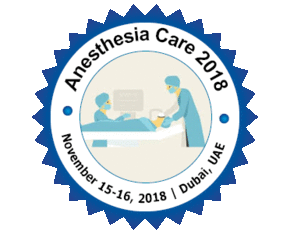
Nagi Amer
Cairo University, Egypt
Title: Combined adductor canal and I-PAK blocks is better than combined adductor canal and periarticular injection blocks for painless ACL reconstruction surgery
Biography
Biography: Nagi Amer
Abstract
The target of the present study is dual. First, to test the hypothesis of combined nerve block addressing different sites of
nerve course can result in more successful distribution and prolongation of block whenever lower concentration local
an anesthetic mixture is used. Secondly to compare combined Adductor Canal and i-PAK Blocks versus Combined Adductor
Canal and Periarticular Injection Blocks For ACL Reconstruction Surgery
Material and methods: The study is a Prospective, randomized cohort study: After IRB (Institutional Review Board) and
committee approval was obtained, Patients aged 18-75 years undergoing ACL Reconstruction Surgery over the period of
one year and included 246 patients which were randomly allocated to either Combined Adductor Canal and i-PAK Blocks Is
(group A), or Combined Adductor Canal and Periarticular Injection Blocks (group B) groups, each had 123 patients at the end
of the study. Informed consent for this study was taken from the patient. This is a scientific abstract with no patient protected
health information. A standard local anesthetic mixture was used throughout the study. The mixture of Ropivacaine 3.75%
with 4 mg of dexamethasone in a total volume of 42 ml of mixture. There are no off -label indications included. No promotional
the content of a commercial entity is included (brand/trade/product names, photos, logos, company names, etc.).
Results: This is a study of the U/S guided comparison of combined Adductor Canal and i-PAK Blocks versus Combined Adductor
Canal and Periarticular Injection Blocks For ACL Reconstruction Surgery demonstrates that of combined Adductor Canal and
i-PAK Blocks results in prolongation of the time before the request for first analgesia rescue (h) (statistically significant) indicated
by higher readings in group A compared to group B. Highly significant difference was also observed comparing the two groups
concerning the total pethidine consumption (mg) in the first 48 postoperative hours with much reduction of the total dose in
group A together compared to group B. Postoperative VAPS at rest and on walking were reduced after of combined Adductor
Canal and i-PAK Blocks at all-time points assessed compared to group B.
Discussion: The combination of distal blocks is having the advantage of being safer approach away from critical structures
and allow preservation of proximal muscle function. The inability to move due to the motor block of proximal and distal
musculature has been shown to decrease patient satisfaction. Distal peripheral nerve blocks are superior at preserving the motor
function of the operative limb. A recent randomized controlled trial addressing this subject in the upper extremity (comparing
ultrasound guided supraclavicular plexus block with distal peripheral nerve blocks for outpatient hand surgery) Showed
better strength preservation and greater patient satisfaction with distal blocks. Using multiple points of blocking the nerves
to reach the sensory terminals supplying the knee region with motor sparing effect can be achieved using lower anesthetic
concentrations. Moreover, combined nerve block addressing different sites of nerve course targeting those which are mainly
sensory can result in more successful analgesia and sparing of motor branches of mixed nerves. The validation of the present
study results essentially requires further large RCT of adequate sample size. The best approach should be tailored to suit specific
surgery whenever possible. This study reiterates the importance of tackling multimodal approach in regional techniques which
probably will have a place in tailoring patient and surgical pain relief needs. Combined Adductor Canal and i-PAK Blocks is
better than Combined Adductor Canal and Periarticular Injection Blocks for For ACL Reconstruction Surgery concerning
postoperative pain.

